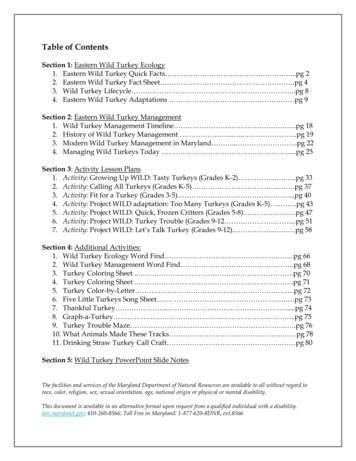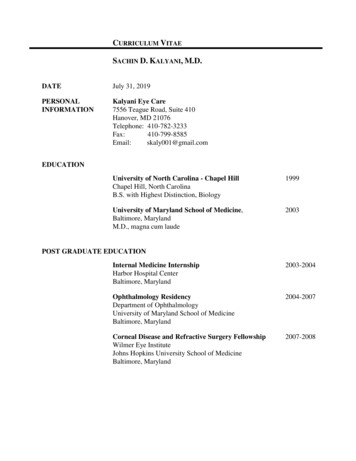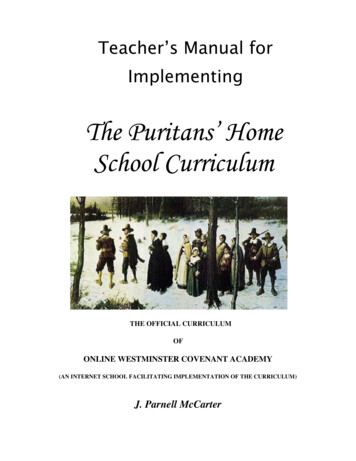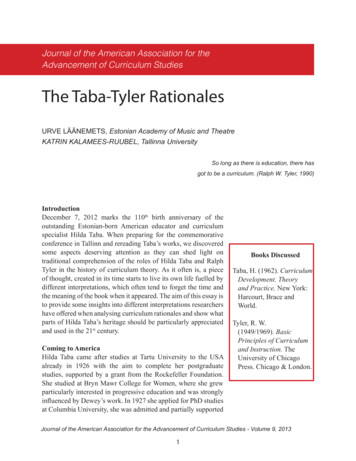
Transcription
Table of ContentsSection 1: Eastern Wild Turkey Ecology1. Eastern Wild Turkey Quick Facts .pg 22. Eastern Wild Turkey Fact Sheet .pg 43. Wild Turkey Lifecycle .pg 84. Eastern Wild Turkey Adaptations pg 9Section 2: Eastern Wild Turkey Management1. Wild Turkey Management Timeline . .pg 182. History of Wild Turkey Management . . .pg 193. Modern Wild Turkey Management in Maryland . .pg 224. Managing Wild Turkeys Today .pg 25Section 3: Activity Lesson Plans1. Activity: Growing Up WILD: Tasty Turkeys (Grades K-2) . . .pg 332. Activity: Calling All Turkeys (Grades K-5) . .pg 373. Activity: Fit for a Turkey (Grades 3-5) .pg 404. Activity: Project WILD adaptation: Too Many Turkeys (Grades K-5) . .pg 435. Activity: Project WILD: Quick, Frozen Critters (Grades 5-8). . pg 476. Activity: Project WILD: Turkey Trouble (Grades 9-12 . .pg 517. Activity: Project WILD: Let’s Talk Turkey (Grades 9-12). . pg 58Section 4: Additional Activities:1. Wild Turkey Ecology Word Find . .pg 662. Wild Turkey Management Word Find .pg 683. Turkey Coloring Sheet . .pg 704. Turkey Coloring Sheet . .pg 715. Turkey Color-by-Letter . .pg 726. Five Little Turkeys Song Sheet . . pg 737. Thankful Turkey . .pg 748. Graph-a-Turkey . . .pg 759. Turkey Trouble Maze . .pg 7610. What Animals Made These Tracks . pg 7811. Drinking Straw Turkey Call Craft . . pg 80Section 5: Wild Turkey PowerPoint Slide NotesThe facilities and services of the Maryland Department of Natural Resources are available to all without regard torace, color, religion, sex, sexual orientation, age, national origin or physical or mental disability.This document is available in an alternative format upon request from a qualified individual with a disability.dnr.maryland.gov; 410-260-8566; Toll Free in Maryland: 1-877-620-8DNR, ext.8566
Section 1:Eastern Wild Turkey Ecology
Eastern Wild Turkey Quick FactsThere are 5 different subspecies of the wild turkey.The eastern wild turkey is the only turkey subspecies found in Maryland.Wild turkeys are most abundant in Maryland’s western counties. However, they canbe found in every county of the state.Adult male turkeys are called gobblers. Juvenile males are called jakes. Gobblersaverage around 18-22 lbs and can have a wingspan of 5 feet.Adult female turkeys are called hens. Juvenile females are called jennies. Adultfemales average half the size of male turkeys.Gobblers are dark brown to black in color with many feathers that are iridescent,with a metallic green and bronze color. Hens are a dull grey-brown in color.During breeding season, the gobbler’s head turns various shades of red, white, andblue. Hens have duller plumage and their heads lack bright colors.Mature males develop spurs on their legs and a beard up to 12 inches in length.Nationally, 10 to 20% of female wild turkeys grow beards.Turkeys are generally found in or near forests. They use open areas to feed and useovergrown fields for nesting.Turkeys are omnivores. Adults eat acorns, leaves, buds, seeds, fruits, waste grains,and insects. Young turkeys mostly rely on protein rich insects.Wild turkeys breed from March-May in Maryland.Once bred, a female turkey will usually lay 9-12 eggs in a shallow nest. Over 50% ofthe resulting poults will not survive.Turkeys use a variety of sounds for communication. The gobble is the most wellknown. Other calls used are yelps, clucks, purrs, and putts.Wild turkeys spend most of the daylight hours on the ground with other turkeys ina flock. They spend night hours in trees to stay out of reach of predators (akaroosting).Turkeys are exceptionally adept at sensing danger. Their color vision is 5 times moreacute than human vision, and their hearing is 4 times better.Turkeys will almost always run when scared but can fly up to 50 miles per hour forshort distances.The average lifespan of a wild turkey is 3-5 years.
Eastern Wild Turkey TaxonomyTaxonomy is the science of identification, naming and classification of living organisms.Taxonomy uses a hierarchal structure that classifies organisms from very broadcategories to very specific categories. In terms of scientific classification, the broadestcategories are Kingdoms while the most specific ones are Species and Subspecies. Thefollowing information details the taxonomic classification of the Eastern wild der-GalliformesFamily- PhasianidaeSubfamily- MeleagridinaeGenus- MeleagrisSpecies- gallopavoSubspecies- silvestrisThe Order Galliformes contains heavy-bodied ground-feeding birds, such as turkey,grouse, chicken, quail, ptarmigan, partridge, pheasant, and the Cracidae family. Thesebirds are commonly called gamefowl or gamebirds, landfowl, gallinaceous birds orgalliforms. This group has about 290 species, one or more of which are found in almostevery part of the world's continents. They are important as seed dispersers andpredators in the ecosystems they inhabit and are often reared as game birds by humansfor their meat and eggs and for recreational hunting.The pheasant family (Phasianidae) within Galliformes consists of the pheasants andpartridges, junglefowl, chickens, Old and New World quail, and peafowl. The family isa large one, and is occasionally broken up into subfamilies such as the Meleagridinae(turkey) subfamily.The Genus Meleagris contains two species- the wild turkey (Meleagris gallopavo) and theocellated turkey (M.ocellata). The wild turkey is the only turkey species native to NorthAmerican forests while the ocellated turkey is native to the forests of the YucatanPeninsula. The wild turkey’s name originates from the European guinea fowl (alsocalled turkey fowl). The first European settlers mistook the bird as a relative to theirguinea fowl. Since the guinea fowl was imported from the country, Turkey, theshortened name “turkey” stuck to the North American bird. There are at least 5subspecies of wild turkey in North America with the eastern wild turkey (M. gallopavosilvestris) being the most widely distributed and abundant subspecies. This subspeciescan be found in Maryland.
Eastern Wild Turkey Fact Sheet(Meleagris gallopavo silvestris)Description & Range:Of the 5 distinct subspecies in North America, only the eastern wild turkey resideswithin Maryland. Wild turkeys are dark brown to black in color with many feathersthat are iridescent, exhibiting a metallic green and bronze color. Male turkeys arecalled gobblers and average 18-22 lbs. During breeding season, their heads turnvarious shades of red, white, and blue. Female turkeys (aka hens) are about half thesize of gobblers. Hen plumage is duller, and they lack the bright head colors. Adultgobblers have spurs, which is a sharp, bony spike on the back of each of their legs.They also have a rough, black beard (hair-like feathers) that protrudes from its breast.The beard can grow up to 12 inches long. Hens do not have spurs and usually do nothave a beard, although bearded hens are not exceptionally rare.Wild turkeys can be found in every county of the state thanks, in part, to an intensivetrap and translocation effort by the DNR with assistance from the National WildTurkey Federation. Although it was once thought that turkeys needed expansive tractsof forest to survive, the wild turkey is quite adaptable and some of the highestdensities are now found in landscapes composed of a mosaic of agricultural lands andwoodlots. Turkeys continue to adapt to human encroachment as well, sometimestaking up residence in suburban areas.Male wild turkeys (left) have more colorful plumage than females (right); Male turkey photo by Dimus, WikimediaCommons and Female photo by Dave Kazyak
Habitat:Wild turkey habitat needs vary depending on the time of year, but generally, turkeysare found in or near forests. Trees provide safe roosting areas and produce much ofthe food that turkeys depend on such as acorns and other mast. However, turkeysspend many hours in open areas as well. Grassy and weedy fields produce insects thatyoung turkeys (poults) need during the summer months. Nesting habitat may be themost limited but is the most important type of habitat turkeys utilize. Wild turkeystypically nest in overgrown fields or other areas with thick vegetation in the form ofbushes, vines, and small trees to obscure a predator’s vision.Diet:Adult turkeys consume a wide variety of foods such as acorns, leaves, buds, seeds,fruits, waste grains, and insects. The primary food of poults for their first few weeks oflife is protein-rich insects, but their diet becomes similar to the adult’s diet as they getolder.Reproduction:During the breeding season (March-May), male turkeys display and gobble to attractfemales and to assert dominance over subordinate males within the flock or theirterritory. Male turkeys will fight over territory or for dominance over their hens. Oncebred, hens will lay about 1 egg per day in a simple nest that is nothing more than ashallow depression in the ground. Incubation of the eggs will begin when the entireclutch is laid (usually about 9-12 eggs). After the 26-28 day incubation period, the eggswill hatch. Wild turkeys are precocial, which means they are born with feathers and canfend for themselves quickly. Poults will leave the nest within 24 hours to forage for foodwith their mothers. Poults have a dull plumage to help camouflage them frompredators. The male turkeys have very little to do with raising chicks. Poults areespecially vulnerable when young. Typically, over 50% of the poults will die due tocold, wet weather or to predators before they are able to fly and roost in trees.Hen turkey with poults.Photo by D.Gordon Robertson, (Wikimedia Commons)
Sounds:Turkeys use a variety of sounds for communication. The gobble is the most wellknown, but they also use other calls such as yelps, clucks, purrs, and putts to attractmates, signal danger, and communicate with the rest of the flock. A turkey gobble canbe heard up to 1 mile away.Behavior:Wild turkeys spend most of the daylight hours on the ground with other turkeys.Flocks of up to 100 birds have been seen in fall and winter, but typically they travel inflocks of 10-30. Flocks will break into smaller groups prior to breeding, and it is notuncommon to see single hens or gobblers during the nesting season. Turkeys areexceptionally adept at sensing danger with color vision 5 times more acute thanhuman vision and hearing 4 times better. Turkeys will almost always run when scaredbut can fly up to 50 miles per hour for short distances.Small flock of turkeys by Kerry WixtedManagement:Wild turkeys are managed as game species in Maryland. The two goals of wild turkeymanagement in Maryland are to 1) ensure that healthy turkey populations aremaintained statewide, and 2) to maintain high-quality hunting opportunities for thosewho are interested in hunting turkeys. More information about wild turkeymanagement can be found in Section 2 of this guide.
Wild Turkey Predator-Prey RelationshipsPredators are animals that eat other animals (prey). Most predator-prey relationshipshave evolved over thousands of years. Some predators are specialists and have alimited set of prey species. For example, mountain lions are specialist predators thatmainly feed on white-tailed deer. Other predators are generalists and will consumewhatever is available. Wild turkeys are both predators and prey.Wild turkeys eat a variety of insects, making them generalist predators. The primaryfood source for the first few weeks of a poult’s life is insects.Wild turkey predators vary by the life stage of the turkey. For example, wild turkey eggpredators include raccoons, skunks, opossums, crows, ravens, dogs, coyotes, weasels,rats and snakes. Once the poults hatch, additional predators include hawks, owls, foxes,cats and eagles. Adult turkey predators include dogs, coyotes, bobcats, foxes, greathorned owls and humans.Coyotes are also wild turkey predators by Jethro Taylor, FlickrBobcat eating a wild turkey by Sue Miseo
Wild Turkey Lifecycle
Wild Turkey AdaptationsAdaptations are traits that help organisms survive and reproduce in their ecologicalniche or habitat. Adaptations occur over many years and can be physical, behavioral orphysiological.Long-tailed weasels have well-developed carnassialsA physical (anatomical) adaptation is one that entails aphysical feature like the shape or color of an animal.Camouflage is an excellent example of a physicaladaptation. Other example of physical adaptations includethe well developed carnassial teeth on mustelids (weasels)that help them shear flesh or the clear eyelids that beavershave to be able to see underwater.Behavioral adaptations are adaptations that have beenlearned or inherited. Language, swarming and use of toolsare all examples of behavioral adaptations.Physiological adaptations permit the organism to performspecial functions. An example of this would be theproduction of venom by timber rattlesnakes. Anotherphysiological adaptation is the process of estivation orwhen some animals enter a state of inactivity duringprolonged periods of drought or high temperatures.Photo by: Robert Barber/Painet Inc.The following pages list physical adaptations of wild turkeys such as their feathers,skeleton, senses, tracks and sexual dimorphism .
Eastern Wild Turkey FeathersEastern wild turkeys are dark brown to black in colorwith many feathers that are iridescent, exhibiting ametallic green and bronze color. There are approximately5,500 feathers on an adult wild turkey including 18 tailfeathers that make up the male's distinct fan. During themating season, the gobblers’ head will become vibrantcolors of red, white, and blue. The exhibition of colorshelps attract potential mates. Female turkeys do notproduce the bright colors during mating season. Ingeneral, hens have duller plumage and lack ofiridescence in their feathers. Poults have feathersIridescence of feathers, Photo byresembling a hen. Poult feathers are drab with grey and (National Wild Turkey Federation)brown coloring. The feather color of hens and poultscreates excellent camouflage. This adaptation allows hens to stay hidden from predatorswhile sitting on its nest. The camouflage also protects poults from predation while theyare too young to defend themselves.Eastern Wild Turkey SkeletonThe eastern wild turkey skeleton is highly adapted forflight. The skeleton is extremely lightweight, but strongenough to withstand the stresses of taking off, flying, andlanding. A majority of the turkey’s bones are hollow withcrisscrossing sections for structural strength. Thisadaptation allows large birds, such as the turkey, theability to fly. Another adaptation of the wild turkey’sskeleton is its keeled sternum. A keel is an extension of thesternum (breastbone), which runs axially along the midlineof the sternum and extends outward, perpendicular to theplane of the ribs. The keel provides an anchor to which abird's wing muscles attach, thereby providing properleverage for flight.
Eastern Wild Turkey SensesWild turkeys have color vision which is 5times better than human vision. Theireyes are located on the sides of theirhead, giving them a 270-degree field ofvision. The wild turkey is capable of seevery well during the day, but their visionis poor at night.The wild turkey can hear 4 times betterthan a human. Turkeys do not haveexternal ear structures; instead, they havesmall holes located behind the eyes.Turkeys have a keen sense of sound andcan pinpoint noises from as far as a mileaway.Turkeys also are highly sensitive totouch in areas such as the beak andfeet. This sensitivity is useful forobtaining and maneuvering food.Turkeys have eyes located on the side of their head. Photo by (Sasha Kopf,)Wikimedia CommonsTurkeys do not have a highly developed sense of smell or taste. The region of the brainthat controls these senses is relatively small. Turkeys have fewer taste buds thanmammals, but can detect salty, sweet, acidic and bitter tastes.Eastern Wild Turkey FeetThe tracks of wild turkey are a classic game bird track. There are three toes pointingforward with one small toe in back. Wild turkey tracks are impressively large, with 3long, bulbous toes and a shorter back toe, which usually only registers as a clawimpression. The tracks measure around 3.5 - 4.5 inches long by 4– 5 inches wide. Turkeys use their large toes to scratch theground to find seeds and dig up insects. Skilled trackers are ableto determine the size of the bird, whether it is male or female,and how quick it was moving just from its tracks.A turkey’s stride is dependent on its speed. Their stride isusually 8-14 inches long. Some turkeys can run up to 19 miles perhour!
Eastern Wild Turkey Sexual DimorphismSexual dimorphism is a phenotypic (physical) difference between males and females ofa given species. These differences can vary from size, color, ornamentation and evenbehavior between the sexes. Not all bird species exhibit sexual dimorphism, but turkeysdo have distinct differences between males and females.In terms of coloration, male turkeys are much more colorful and more iridescent thanfemales. This color difference is partially due to the fact that wild turkeys nest on theground, so females have drab coloring used for camouflage.Male wild turkeys also have a structure known as a snood. The snood is a fleshyappendage that attaches just above the beak. When gobbler (aka tom) relaxes, the snoodis short — maybe half an inch long. However, when the gobbler struts, the snoodengorges with blood and extends to hang down over the beak.Photo by Malcolm, Wikimedia CommonsWild turkeys also have dewlap (AKA wattle). This structure is a large patch of skin thathangs between their beak and neck. While both males and female turkeys have adewlap, the structure is much more pronounced in male turkeys. In addition, agobbler’s dewlap and head are able to quickly change colors as their emotions change.
When it is breeding season, the gobbler’s head will become more bright and vibrant incolor. This feature is a tool used to impress hens.On both the sexes, the caruncles are fleshy, bulbous bumps that grow over the head andneck. Even though they are less pronounced on females, the caruncles on a male turkeygrow large and are especially pronounced on the lower portion of the neck. Usuallypale in color, the caruncles engorge with blood and turn to bright red when the turkeystruts or becomes aggressive.One of the most noticeable gobbler featuresis its beard. Around 11 weeks of age, maleswill begin growing their beard. The beard isa rough, black, hair-like feather that growsfrom the bird’s breast. Scientists call the“hairs” of the beard “bristles” or“mesofiloplumes”.Young turkeys willusually have shorter beards than maturegobblers . Beards grow continuously butusually their maximum length is about 11-12inches because they drag on the ground andwear off. However, some birds have grownbeards as much as 18 inches in length!Across the United States, 10-20 percent offemale turkeys grow beards. In addition,some turkeys can grow multiple beards.Rio Grande Gobbler photo (note beard & uniform tailfeather length as well as buff-tipped tail feathers) courtesyof Freezo, Wikimedia CommonsMale turkeys also have prominent tail fans.Made up of 18 tail feathers 12 to 15 incheslong, tails fans are used by toms to attract females during the breeding season. Jakes(juvenile males) have middle tailfeathers that are longer than the rest ofthe tail feathers. In contrast, adult maleshave tail feathers uniform in length. Thetail feathers that make up the fan alsoaid in identifying the subspecies ofturkey. On eastern wild turkeys, the tailfeathers have brown tips while the tipsof Rio Grande turkeys’ tails are buffcolored.Gobblers also have spurs whichprotrude from the back of their legs. Thespur is a hard bony structure that isEastern wild turkey jake tail fan as evidenced byuneven tail feather length and brown tips on feathers
used in fighting between turkeys. Gobbler’s spurs are also used to determine the age ofthe bird. A jake, up to one year old, will have short, nub-like spurs up to ½ inch inlength. A two year old will have straight spurs ½ to 1 inch in length. Gobblers 3 yearsand older will have spurs 1 inch in length and longer. Gobbler’s spurs are also muchsharper and have a slight curve to them. Hens lack spurs on their legs.
GlossaryAdaptation- traits that help an organism surviveBeard- rough, black hair-like feather that grows from the breast of male wild turkeysCaruncles- fleshy, bulbous bumps that grow over the head and neckDewlap aka wattle- patch of skin between head and neck of a wild turkeyFlock- a group of turkeys assembled togetherEstivation- when animals enter a state of inactivity during prolonged periods ofdrought or high temperatures.Galliformes- heavy-bodied ground-feeding birds, such as turkey, grouse, chicken, quail,ptarmigan, partridge, pheasant, and the Cracidae familyGobbler- an adult male turkey; over 1 year of ageHen- an adult female turkey; over 1 year of ageJake- a juvenile male turkey; less than 1 year of ageJennie- a juvenile female turkey; less than 1 year of ageKeel- is an extension of the sternum (breastbone), which runs axially along the midlineof the sternum and extends outward, perpendicular to the plane of the ribsMeleagridinae- (turkey) subfamily of PhasianidaeMeleagris- Genus which contains two species- the wild turkey and the ocellated turkeyOmnivore- An animal or organism that feeds on both animal and plant matter
Phasianidae- pheasants and partridges, including the junglefowl (including chicken),old world quail, francolins, monals and peafowlPoult- a young turkey that has recently hatchedPrecocial- young that are relatively mature and mobile from the moment of birth orhatchingPredator- an animal that eats another animalRoost- the place where birds rest or sleep; wild turkeys roost in treetopsSexual dimorphism- phenotypic differences between male and females of a givenspeciesSnood- a fleshy appendage that attaches just above the beak on a wild turkeyTaxonomy- the science of identification, naming and classification of living organisms
Section 2:Eastern Wild TurkeyManagement
Wild Turkey Timeline 1.8-5 million years ago- Wild turkeys evolved800 & 200 BC- Turkeys domesticated by Aztecs and PueblosEarly 1500s – Spanish conquistadors import wild turkey to EuropeEarly 1600s – Settlers bring forms of domesticated turkey to back North America1626- Plymouth Colony passes first conservation law limiting timber harvest1708- Colony of New York passes first wild turkey hunting regulation1813- Wild turkey extirpated from ConnecticutEarly 1900’s – Very few of Maryland’s wild turkey flock remain1919 - State Game Warden F. Lee LeCompte said, “Wild turkeys, outside of a fewsections in the Western counties of our State, are practically extinct”1920- Wild turkey extirpated from 18 states1920-1933 – Turkey hunting prohibited in Garrett County1925 – Maryland initiated a program of buying and releasing pen-raised turkeys1930-1971 – Maryland establishes its own game farm raising and releasing over33,000 turkeys into the wild1950’s – Rocket net developed and perfected1960’s – Turkey populations increase in Fredrick and Montgomery Counties1967 – Rocket net used for the first time to capture wild turkeys in GarrettCounty to release in Fredrick County1971 – Raise and release program abandoned over trap and transplant program1973 – Estimated 2,000 wild turkeys remained in Maryland1978 – Wild Turkey Advisory Committee established1979-2001 – 1,129 wild turkeys captured by rocket nets were released at 63 sitesthroughout the state2001 – Self-sustaining wild turkey populations are seen throughout Maryland.Trap and transplant program suspended2003-Present – Approximate population of wild turkey in Maryland is over30,000 birds; turkey management includes: population surveys, habitatmanagement, and hunting regulations
History of Wild Turkey ManagementPre-Colonial EraIt is believed that the wild turkey evolved from pheasant-like birds that became isolatedin North America. Fossil records date the presence of the earliest wild turkeys species to1.8-5 million years ago in the late Pliocene Epoch.The wild turkey was used by some Native American cultures as a food and textileresource. At the time, wild turkeys were less wary of humans and were easily captured.Some Native Americans were able to use nets, pens, and snares to capture the birds, butshooting them or capturing them by hand on the roost were the easiest forms ofcollection. Due to their ease of capture, some Native American tribes, such as theCherokee and Chickasaw, allowed children to hunt turkey with an early form of a blowgun known as a sarbacane.Many tribes throughout North America relied heavily on the wild turkey as a foodsource. Archaeological evidence has shown the wild turkey was used extensively forfood in many Native American tribes and was only second to deer as a food source.Other Native American tribes had religious customs against eating certain wildlifespecies. The Apache would not eat wild turkey, quail, and dove while the Cheyennebelieved that consuming wild turkey would make them cowards. Other tribes did nothunt the bird because they found turkeys to be “careless and foolish”.Native Americans utilized the wild turkey not only for food but also for clothing andtools. The turkey’s feathers were used to make blankets,quilts, dresses, and coats. Native American womenwould weave turkey feathers into cord made fromhemp, yucca, or basswood to create the various formsof clothing. The Native Americans also developed toolsout of turkey bones to assist with everyday activities.Spoons and awls were made out of hollow turkeybones, and the earliest forms of game calls were madefrom turkey bones combined together. NativeAmerican hunters used turkey spurs for arrow tips andfeathers for fletchings.Wild turkeys also were used in ceremonies by sometribes. Beards and vibrant feathers were used todecorate prayer sticks. In Virginia, men would hangturkey legs from their pierced ears, and pieces ofbones were used by some to create ornaments anddecorative beads.Native American feather neckornament composed of wild turkeyfeathers. Photo by: Dr. Frank G. Speck(Wikimedia Commons)
At least two separate groups domesticated wild turkeys between 800 and 200 B.C. TheAztecs and Pueblos both had domesticated forms of the wild turkey which wereallowed to roam around the villages and in some cases, were in pens. Motolinia, aFranciscan priest, estimated that over 8,000 turkeys were sold every 5 days in Tepeyac,a city in Mexico. The early domestication of the wild turkey was due, in part, to theNative American’s use of the turkey’s feathers for rituals and ceremonies. Around 1100A.D., the Anasazi (ancient Puebloans) utilized the domesticated turkeys as a foodsource. Many eastern Native American tribes followed the Pueblo in using the turkeyfor its meat as well as its feathers although they did not domesticate it.After the arrival of the Spanish conquistadors in the early 1500s, the wild turkey wasimported to Europe and further domesticated. The presence of the turkey quicklyspread throughout all of Europe. During the 1600s, the settlers brought thedomesticated turkeys back to North America from Europe. Interestingly enough,domesticated turkeys today can be traced back to the Aztec turkeys. The domesticatedturkey can now be found in captivity world wide.Colonial EraAt the time the first European settlers arrived in North America, wild turkeys wereabundant throughout the eastern United States and Mexico (Figure 1). The earlypioneers relied on the wild turkey as an important source of food. Turkeys were huntedyear round with no game laws (hunting regulations). With a growing nation and ademand for lumber, large tracts of forest were cleared for farmland, buildings, andvillages as well as to create a border between villages. This extensive deforestationdestroyed much of the wild turkey’s natural habitat.
Unregulated hunting coupled with mass deforestation led to the first noticeable declineof the wild turkey population in the 1600s. In 1626, the Plymouth Colony passed thefirst conservation law limiting the cutting and sale of colonial lumber. Later in 1708, theColony of New York passed the first wild turkey regulation prohibiting the hunting ofwild turkeys during nesting and brood rearing seasons. Soon after, many other coloniesestablished hunting regulations for wild turkeys. Even with forest and huntingconservation laws in effect, the need for land, lumber, and food continued to devastatethe population of wild turkeys. With the wild turkey’s habitat quickly declining, andthe pressure on hunters to feed the growing number of colonists (4 million by 1790), thewild turkey began to disappear. Connecticut lost its wild turkeys by 1813. In 1842, wildturkeys were extirpated from Vermont. Other states quickly followed. By 1920, the wildturkey had been extirpated from 18 of the original 39 states and Ontario, Canada(Figure 2).Figure 1: Historic range of wildturkey subspecies by C. F. Speller etal. (2010)Figure 2: States wild turkeyextirpated from in 1920
Modern Wild Turkey Management in MarylandBy the turn of the 20th Century, only a remnant of Maryland’s once abundant wildturkey flock remained. Concern over low turkey populations resulted in a prohibitionon turkey hunting in Garrett County from 1920 to 1933. In 1925, Maryland initiated aprogr
Eastern Wild Turkey Taxonomy Taxonomy is the science of identification, naming and classification of living organisms. Taxonomy uses a hierarchal structure that classifies organism










